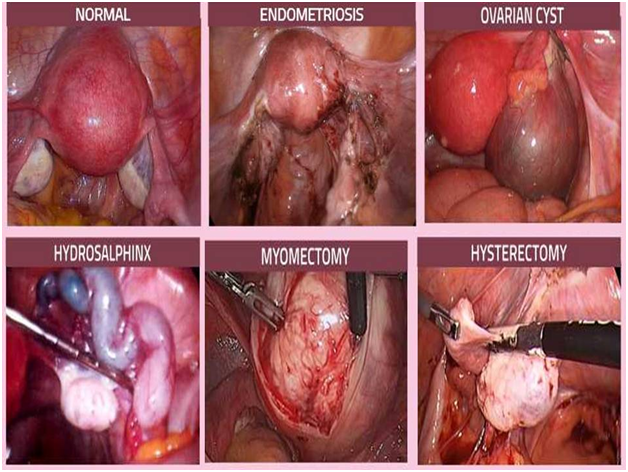Diagnostic & Operative Hystero - Laparoscopy

A spacious and well equipped (instruments of international brands) endoscopy unit is one of our pride.......
Dr. Neha Lad has acquired advanced training in pelvic endoscopy from Standford University.
She has a wide experience of 23 years performing female pelvic endoscopy.
HYSTEROSCOPY

Hysteroscopy involves the placement of an telescope (the hysteroscope) through the dilated cervix, directly into the uterine cavity (womb). Abnormalities inside the uterine cavity such as scar tissue (from prior infection or pregnancy), fibroids, polyps, or malformations (mullerian anamolies) can be found, and repaired at the same time, during hysteroscopy.No incisions are required for this, and the procedure usually takes about ten minutes. The recovery from a hysteroscopy is generally only 24-48 hours, since no incision is required. Risks are minimal, and include very low chances of bleeding, infection, or uterine perforation.
Diagnostic hysteroscopy involves examining the cervix, the volume & distension of the uterine cavity, the inner lining (endometrium) of the uterus and presence of any abnormality or infection. The piece of endometrium is sent for TB-PCR test to discover the presence of genital tuberclosis infection.
Operative hysteroscopy generally involves -
- Polypectomy - removal of polyps
- Myomectomy - removal of fibroids
- Adhesiolysis - removal of bands of Asherman's Syndrome
- Septoplasty - removal of septum (correcting uterine defects)
Combining hysteroscopy with laparoscopy enables an "inside and outside" view of the uterus.
LAPAROSCOPY

Laparoscopy is the most direct and least invasive way to assess pelvic anatomy. Under general anesthesia with you completely asleep, a small telescope (the laparoscope) is inserted through the navel, through which we view your internal pelvic anatomy.
Often the chief reason for infertility or miscarriage may involve the presence of scar tissue, endometriosis, fibroids, ovarian cysts or other pelvic disorders. These same conditions may also result in pelvic pain, abnormal bleeding or other gynecologic complaints. Your laparoscopy will define whether these or other conditions involve your cervix, uterus, fallopian tubes, ovaries or entire pelvis.
Following laparoscopy, 3-4 days is the average recovery time. Some amount of abdominal pain often persists for a few days for which pain relief medications are prescribed.
Diagnostic Laparoscopy involves the following examinations:
- Condition of the uterus from outside - size, shape, etc.
- Condition of the fallopians tubes whether patent or not by performing dye test.
- Condition of the ovary - size, presence of cysts.
- Condition of the other adjacent organs
Operative Laparoscopy generally involves -
- Myomectomy - removal of fibroids
- Adhesiolysis - removal of adhesions bands
- Fulguration - removal of endometriotic spots
- Ovarian Cystectomy - removal of ovarian cysts
- Salpingectomy - removal of fallopian tube due to ectopic pregnancy or hydrosalpinx (inflammation)
- Hysterectomy - removal of the uterus
- Total Hysterectomy - removal of all the reproductive organs
